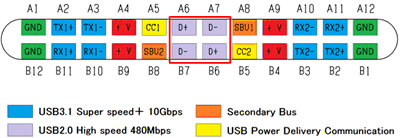SCDS377B March 2018 – June 2018 TS5USBC41
PRODUCTION DATA.
- 1 Features
- 2 Applications
- 3 Description
- 4 Revision History
- 5 Pin Configuration and Functions
- 6 Specifications
- 7 Parameter Measurement Information
- 8 Detailed Description
- 9 Application and Implementation
- 10Power Supply Recommendations
- 11Layout
- 12Device and Documentation Support
- 13Mechanical, Packaging, and Orderable Information
Package Options
Refer to the PDF data sheet for device specific package drawings
Mechanical Data (Package|Pins)
- YFF|12
Thermal pad, mechanical data (Package|Pins)
Orderable Information
8.1 Overview
The TS5USBC41 is a bidirectional low-power dual port, high-speed, USB 2.0 analog switch with integrated protection for USB Type-C systems. The device is configured as a dual 2:1 or 1:2 switch and is optimized for handling the USB 2.0 D+/- lines in a USB Type-C system as shown in Figure 16.
 Figure 16. USB Type-C Connector Pinout
Figure 16. USB Type-C Connector Pinout
The TS5USBC41 also works in traditional USB systems that need protection from fault conditions such as automotive and applications that require higher voltage charging. The device maintains excellent signal integrity through the optimization of both RON and BW while protecting the system with 20 V (TS5USBC410) and 24 V (TS5USBC412) OVP protection. The OVP implementation is designed to protect sensitive system components behind the switch that cannot survive a fault condition where VBUS is shorted to the D+ and D- pins on the connector.